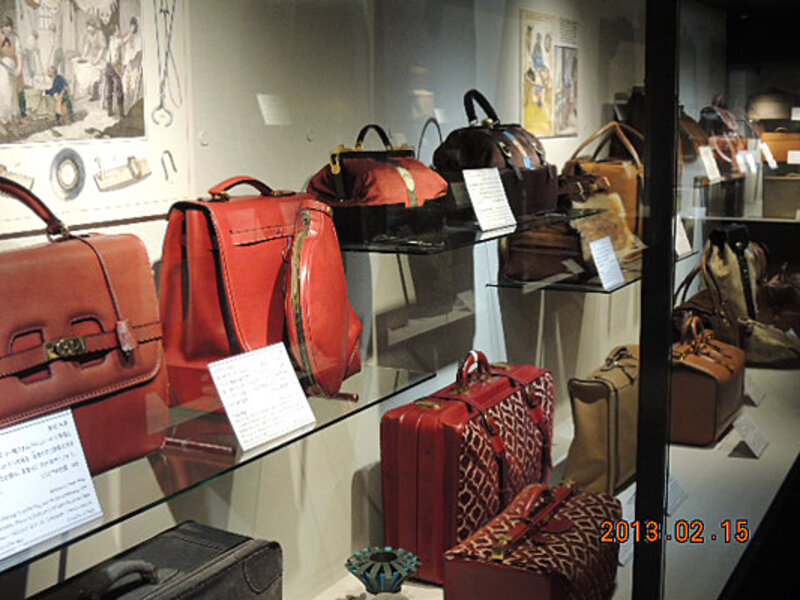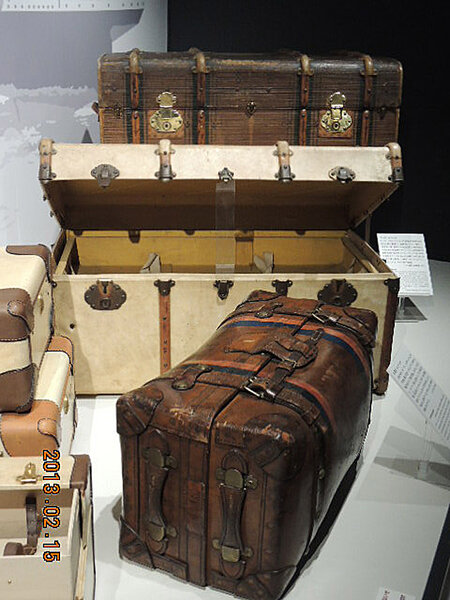How many frogs does it take to make a handbag? Tokyo museum has the answer
Loading...
| Tokyo
Hidenori Hirosaki acknowledges that the museum of which he is the director is “unusual.”
He is proud, he says, that “it is unique. There is no other museum with this concept in the world.”
Mr. Hirosaki is the director and driving force behind the World Bags and Luggage Museum, a shrine that imbues the humble suitcase with a sacred quality.
On display, picked out like jewels by artful lighting, are satchels and steamer trunks, backpacks and portmanteaus, clutch bags and briefcases from around the world and down the ages.
The collection began with Ryusaku Shinkawa, the founder of ACE, a Japanese luggage manufacturer, who gathered many of the pieces that are now on show for the small and little-visited museum. The late Mr. Shinkawa, described in the museum brochure as “pursuing bag as divine vocation,” was clearly passionate about his business.
Hirosaki has inherited his enthusiasm, and his taste is eclectic. As a man who has worked for ACE and lived with leather all his adult life (“the first thing I notice about a man is his shoes,” he says), he cannot disguise his preference for perfectly tanned cowhide and the workmanship that went into classic Italian luggage in the 1960s.
But he is just as keen to show off a navy blue Panam flight bag, made in 1960, which Hirosaki explains in the descriptive panel alongside the bag, was “a longing symbol of overseas travel for us Japanese.” Japanese were not allowed to go abroad, except on business or to study, until 1964, he recalls.
The museum, housed on the seventh floor of the ACE corporation’s headquarters, owns about 600 pieces (and the collection is growing: Hirosaki bought the Panam bag last year on eBay for $150) but only half of them are on display. Even so, they encompass an extraordinary variety of things for putting things in.
Zebra, water buffalo, hippopotamus, oh my
There is a pair of zebra skin travel bags; an elephant hide suitcase that once belonged to a Kuwaiti emir; one attaché case made from rich yellow water buffalo hide, another of hippopotamus leather, and a third from deeply crevassed sharkskin.
There is a trunk covered with the black skins of 12 saltwater crocodiles, gleaming like patent leather; there is an elk-skin shoulder bag from Finland, a barrel-topped Saratoga trunk from the United States, and an elegant clutch made in Thailand from a patchwork of pale green and delicate yellow rectangles.
“A considerable number of frogs are needed to make a single bag,” a sign explains.
And did you ever wonder why a Saratoga trunk had that distinctive barrel-shaped lid? In the days of carriage and train travel when cases were piled on top of each other, a Saratoga trunk could only go on top of the pile, thus running less risk of damage.
The museum embraces the modern and the practical with as much ardor as it reserves for the exotic and luxurious. Hirosaki waxes lyrical in his description of the first Samsonite suitcase that ACE made under license, (the classic Silhouette, whose subtle wedge shape has defined the brand for half a century), describing it as “a flower on a lofty height.”
From Halliburton to Gucci
In another glass display case nearby is an even more prosaic looking item – a grey aluminum box with an orange Bakelite handle, secured by a couple of hasps.
This, it turns out, is the toolbox that Richard Halliburton designed for himself in 1938. The American engineer, scion of the oil-services giant bearing his name, “through his bitter experience in the Middle East that inside of a bag get covered in sand, decided to invent a case of his own satisfactory,” Hirosaki’s sign explains in somewhat fractured English.
A very similar, though somewhat larger, box was used by the Apollo 11 crew to store moon-rocks, says a sign. “The spec. was nothing special, with slight interior modification, which proved the case valid in universe.”
Valid throughout the universe. What greater praise could be bestowed on a travel accessory?
Just before the exit, the last display area in the museum shows off ACE’s current output – fairly standard pieces of lightweight, robust luggage in bright colors equipped with the casters and pullout handles familiar from airports the world over.
Hirosaki is proud that ACE is Japan’s only remaining luggage manufacturer, but he cannot hide his nostalgia for the glory days of luxury travel and the exquisitely crafted baggage that went with it.
“Today people put too much stress on rationality, functionality, and efficiency,” he sighs, admiring a strapped suitcase made from natural leather by the Italian company Franzi (where Guccio Gucci got his start) half a century ago.
The sign beside the case is simple and eloquent. “The same cannot be manufactured under the present circumstances of attaching too much emphasis to productivity,” it says. The World Bags and Luggage Museum is an unexpected reminder of how much more than a bag a bag can be.
(The museum can be found in the Asakusa district of Tokyo at 1-8-10 Komagata, Taito Ku, Tokyo. Phone 03-3847-5680)









